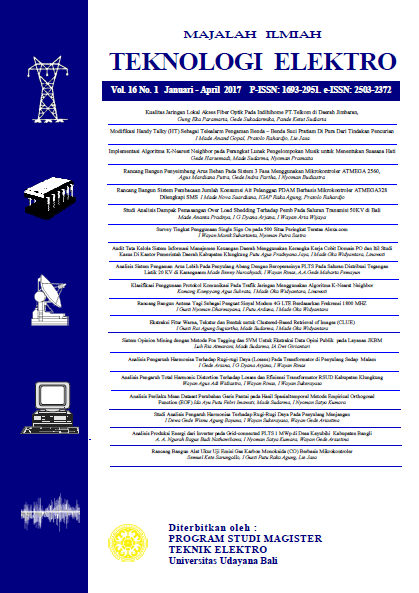Analisis Perilaku Mean Dataset Perubahan Garis Pantai pada Hasil Spasialtemporal Metode Empirical Orthogonal Function (EOF)
Abstract
The purpose of this study is to apply EOF method on shoreline change resulting spatialtemporal analysis mode 1 and also to to prove the mean behavior on the spatial or temporal of its EOF outcomes. The data used was obtained from shoreline coordinates of shp file of the Bali island map and the result of breaking waves study, by using a one-dimensional modeling yielded dataset or prediction shoreline changes during 91 months. Calculation EOF 1, the input matrix or dataset was initially not reduced by the mean but EOF 2 vice versa. Each matrix receive the same treatment were calculated covariance, eigen value, eigen vector and principal component. EOF calculations obtained the last five eigen value, the last five eigen vector, trace, principal component and variant data. Based on the results obtained were compared parameters of two matrices mentioned before.
Spatially results both of EOF 1 and EOF 2 shows the same eigen vector represented by the first mode of eigen vector. Similarly, the eigen value, trace and variance of data, produce the same information. Significant difference occurs in the principal component (temporal). EOF 1 shows that the value of the first month produces a positive value, second month until month 91th output are minus. EOF 2 shows the value of the principal component the first month until the 37th month are in a positive position, then from month 38th to month 91th yielded negative results. Nevertheless EOF 1 and EOF 2 showed shoreline changes tend to be erosion.
Tujuan dari penelitian ini adalah menerapkan metode EOF pada perubahan garis pantai sehingga menghasilkan analisis spasialtemporal mode ke-1 dan juga untuk membuktikan perilaku mean pada hasil spasial atau temporal hasil EOF tersebut. Data yang digunakan diperoleh dari koordinat garis pantai file shp dari peta pulau Bali dan hasil studi gelombang pecah, dengan menggunakan pemodelan satu dimensi menghasilkan dataset atau prediksi perubahan garis pantai selama 91 bulan. Perhitungan EOF 1, matriks input atau dataset awalnya tidak dikurangi dengan rata-rata tetapi EOF 2 sebaliknya. Setiap matriks menerima perlakuan yang sama dihitung covariance, eigen value, eigen vektor dan principal component. Dari perhitungan EOF diperoleh eigen value lima terakhir, eigen vcktor lima terakhir, trace, principal component dan variance data. Berdasarkan hasil yang diperoleh dibandingkan parameter dua matriks sebelumnya.
Secara spasial hasil EOF 1 ataupun EOF 2 menunjukkan nilai eigen vector yang sama yang diwakili oleh eigen vector mode pertama. Demikian pula pada eigen value, trace dan varian data, EOF 1 dan EOF 2 menghasilkan informasi yang sama. Perbedaan yang siginifikan terjadi pada principal component (temporal). Dari EOF 1 didapatkan bahwa nilai temporal bulan ke-1 menghasilkan nilai positif, bulan ke-2 hingga bulan ke-91 output bernilai minus. Pada EOF 2 nilai principal component ke-1 hingga bulan ke-37 berada pada posisi positif, selanjutnya dari bulan ke-38 hingga bulan ke-91 menghasilkan nilai negatif. Meskipun demikian EOF 1 dan EOF 2 tetap menunjukkan garis pantai yang cenderung mengalami erosi.
Downloads
References
[2] Kuriyama, Y. Masayuki Banno, Hiroyuki Kishi, Toshifumi Satoh and Kunio Mizuuchi. Morphological Change Of Nourished Beach Behind Submerged Breakwater on The Niigata Coast. Seventh International Conference on Coastal Dynamics 2013, p.1015 – 1024. 2013.
[3] Arkwright D. dan Suntoyo . Application Of Empirical Orthogonal Function Models To Analyze Shoreline Change At Bangkalan Madura. Makara, Teknologi, Vol. 15, No. 2, November 2011: 153-160. 2011.
[4] Luhwayudin M., Suntoyo, dan Wahyudi Citrosiswoyo. Analisa Perubahan Garis Pantai Tegal dengan Menggunakan Empirical Orthogonal Function (EOF). JURNAL TEKNIK ITS Vol. 1, (Sept, 2012) ISSN: 2301-9271. 2012.
[5] Azhar M. R., Suntoyo, Mahmud Musta’in. Analisa Perubahan Garis Pantai Tuban, Jawa Timur dengan Menggunakan Empirical Orthogonal Function (EOF). JURNAL TEKNIK ITS Vol. 1, No. 1(Sept. 2012) ISSN: 2301-9271. 2012.
[6] Ivanoviq A, Suntoyo, S, Kriyo. Analisa Karakteristik Perubahan Garis Pantai Lebih Kabupaten Gianyar dan Kondisi Lingkungan Sekitar dengan Empirical Orthogonal Function (EOF). Tugas Akhir Teknik Kelautan FTK-ITK. Surabaya. 2011.
[7] Miranda, A.A., Le Borgne, Y. & Bontempi, G. New Routes from Minimal Approximation Error to Principal Components. Neural Processing Letters. Springer. Vol. 27. P.197-207. doi:10.1007/s11063-007-9069-2. 2008.
[8] Alvarez, F. dan Pan, S. Predicting Coastal Morphological Changes with Empirical Orthogonal Function Method. Water Science and Engineering 2016, 9(1): 14-20. 2016.
[9] Shi, R.X., J.F. Wang, C.D. Xu, S.J. Lai, W.Z. Yang. Spatiotemporal Pattern of Hand-Foot-Mouth Disease In China: An Analysis of Empirical Orthogonal Functions. Elsevier. P.367-375. 2014.
Keywords

This work is licensed under a Creative Commons Attribution 4.0 International License





